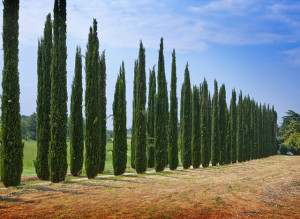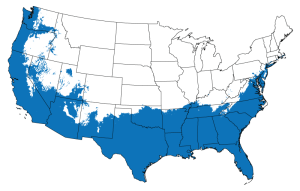Seed Propagation Italian Cypress

Row of Italian Cypress http://www.srhtrees.com/wp-content/uploads/2014/07/Italian-Cypress-shutterstock_168075086.jpg%5B/caption%5D
Italian Cypress (Cupressus sempervirens) is an evergreen tree known for its column shape that can reach heights of 60 feet tall and about 10 feet wide. This tall and narrow shape is distinctive. These trees, which grow in U.S. Department of Agriculture hardiness zones 7b through 11, are mostly utilized as an accent plant and can create a wall used for privacy around a home or busniess. Commercially available Italian cypress plants are relatively expensive, so growers may elect to grow this plant from seed. Fortunately, Italian cypress seeds germinate readily, especially if stratified
[caption id="attachment_185" align="aligncenter" width="300"] Plant hardiness Zones 7-11
Plant hardiness Zones 7-11(https://www.thetreecenter.com/italian-cypress/)
The Italian Cypress is originated from countries located in the Western Mediterranean like Greece, Turkey, Israel, Italy and Lebanon. It has also been cultivated in other countries, but mainly Italy, for centuries, hence the name Italian Cypress. This beautiful tree grows tall and narrow on its own so not too much pruning is necessary to keep this tree’s shape.

In a Mediterranean
environment.
http://www.plant-rhizome.org/wp-content/uploads/2015/04/Italian-Cypress-Trees.jpg%5B/caption%5D
The preferred method of propagation for the Italian Cypress is by seeds or cuttings. Grafting and tissue culture is typically not used because they are time consuming, expensive and have a lower success rate than the other two methods. Although seed propagation is preferred, this method still has its downsides. Seed propagation requires much time and patience. If the grower wants to propagate at a faster pace they may want to use a different method such as grafting. When starting the process with a seed it can take up to a year or even longer for it to go from a germinated seed to a seedling ready to be planted.
These are the supplies you will need:
- Cypress Seeds
- Pots
- Propagation media
- Peat moss or sawdust
- Plastic bag
Gathering seeds for Propagation:
The first step you will want to take is collecting the Italian Cypress seeds. This can be done one of two ways, either from a commercial seed producer or by collecting the seeds from the tree itself. The seeds may be collected from the tree’s cones once they are mature in Fall. The cheapest way to obtain the seeds is by locating a mature tree outside and collecting the cones. The cones contain a decent amount of seeds. If you do not have access to an Italian Cypress you can easily order a packet of seeds from an online seed producer. For this situation we will collect them from a cone.
- Collect ripe cones from the Italian cypress in fall before the cones are on the ground. Break the cone open to collect seeds. Either store the seeds in a cool, dry place or begin the stratification or scarification process. Seeds in storage remain viable for several years.
 Seeds from cone. (http://www.plant-rhizome.org/wp-content/uploads/2015/04/Italian-Cypress-Trees.jpg)
Seeds from cone. (http://www.plant-rhizome.org/wp-content/uploads/2015/04/Italian-Cypress-Trees.jpg)Scarification-The seeds of many plant species are often impervious to water and gases, thus preventing or delaying germination. Any process designed to make the seed coat more permeable to water and gases is known as scarification.
Stratification– the process of treating stored or collected seed prior to sowing to simulate natural winter conditions that a seed must endure before germination. Some seed species undergo an embryonic dormancy phase, and generally will not sprout until this dormancy is broken.
- We will stratify the seeds for at least 3 weeks before sowing them. The seeds should be placed in a container or plastic bag that contains peat moss or sawdust that is slightly damp. The container should then be placed in an area that has a temperature between 35 and 45 degrees Fahrenheit for the greatest success rate. A refrigerator would be a good place to store them to accomplish this.
- Next we will want to prepare the germination container with the propagation medium. Soil that is heavy in peat or compost is preferred for ideal growth. Use disinfected flats or pots with several drain holes and a sterile, well-drained medium.
- After the stratification process is complete you may sow the seeds in the germination container you put together in the last step.
- Cover the seeds in about ⅕ inch of your preferred soil and wet the soil.
- The germination container should be in indirect, but bright light. The temperature should be kept between 65 and 70 degrees Fahrenheit for the greatest chance of growth.
- The medium should be in an area where it can be regularly misted, like a greenhouse. The soil should never dry out.
- The seedlings should sprout in about one to two months.
- Transplant seedlings into pots with well-drained, rich propagation medium once the seedlings are large enough to handle with ease. Keep the seedlings in these containers for close to a year. Overwinter them indoors or in a protected site their first winter before planting them in their permanent locations the following spring.
The young Italian Cypress will sprout up to 3 feet a year, slowing down in growth progress as it matures. Your young trees should establish themselves in a relatively short amount of time to create the screen you want. For the best plant possible, the Italian Cypress should be treated with the appropriate fertilizer. This tree can survive droughts fairly well, but still make sure it is watered regularly to promote the growth of a sturdy and healthy plant. As for managing stressors, this tree is resistant to deer, and can withstand fires. However, monitor your tree for mites and cypress canker.
The Italian Cypress is a tall, columnar tree, growing to about 60 feet tall and 10 feet wide. It is an evergreen with soft foliage and beautiful round cones that will grow in any sunny, dry area in all kinds of soil. It functions as a unique accent plant. You can create columns on each side of a door or driveway and it is an is also the ideal choice for a screen in a confined space as it will naturally grow tall but narrow. It grows quickly, can survive drought and resistant to many stressors. This unique plant makes a gorgeous tall column of green to add a dash of sophistication to any part of your garden or home.

Trees used in landscaping. (http://images.fast-growing-trees.com/images/P/Italian_Cypress_450_MAIN.jpg)
Works Cited
Hartmann, Hudson T., Dale E. Kester, Fred T. Davies, and Rovert L. Geneve. Hartmann & Kester’s Plant Propagation: Principles and Practices. 7th Ed. Prentice Hall, 2002. 820. Print
“Italian Cypress.” The Tree Center. N.p., n.d. Web. 24 Apr. 2016.
Ryczkowski, Angela. “How to Start Italian Cypress Plants From Cones.”Home Guides. N.p., n.d. Web. 24 Apr. 2016.
